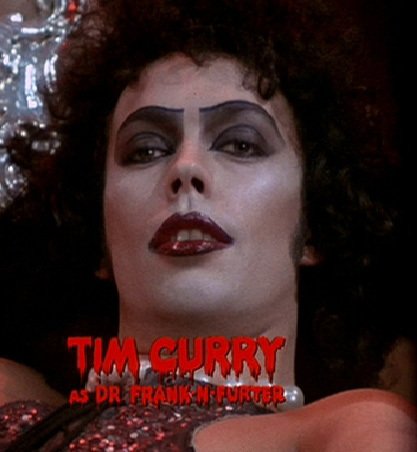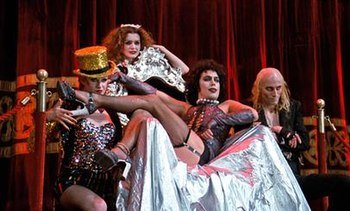Celebrating the History of Queer Horror: Dr Frank N. Furter in The Rocky Horror Picture Show
By Oscar Appleyard-Keeling, 2nd Year Film and TV
As Halloween draws closer, the Bristorian considers the deliciously camp ties between horror films and queerness. Spotlighting Dr. Frank. N Furter, an icon of queer cinema, Oscar discusses the much-loved horror classic, The Rocky Horror Picture Show….
The ‘Sweet Transvestite from Transexual, Transylvania’, Dr Frank N. Furter is one of the iconic queer characters whose image is burnt into the zeitgeist through the phenomenon of The Rocky Horror Picture Show. Frank N. Furter was performed most iconically by Tim Curry in the 1975 film adaptation of the 1973 musical, which also starred Curry. Both musical and film were written by Richard O’Brien, also starring in both as Riff Raff, and directed by Jim Sharman with the film’s screenplay being co-written by both. It was inspired by science fiction and B-Horror movies, with the idea to meld the two, especially the humour of B-Horror movies, and add in rock ‘n’ roll to make it a musical. This idea shifted to being glam rock instead bringing together the core elements of what makes Rocky Horror what it is.
The character of Dr. Frank N. Furter is portrayed as a heightened version of both femininity and masculinity. He is physically masculine, using he/him pronouns and not hiding but highlighting his genitals, while simultaneously subverting gender expression norms by wearing lingerie, make-up, and pearls. He also portrays himself in a traditional Hollywood feminine light with the way he talks and acts with expression. In a contemporary setting, Frank could best resemble a drag performer of some kind, playing with, mocking and challenging ideas of gender conformity, especially ideas surrounding sex and sexual liberation. However, Frank is not a drag performer; though sharing aspects, Frank is simply what he is. Everyone in the film accepts Frank’s gender presentation and many are attracted to Frank because of his gender presentation.
A vital aspect of his character of Frank is his sexuality. Like many depictions of queer people in cinema and other media he is portrayed as a highly sexual being, including showing the trope of queer characters “turning” other characters gay. However, I would argue that this is different from other uses of this trope as Frank is written by queer people, and this expression of sexuality is not seen through the usual lens as a form of degeneracy but as liberating.
Flirtatiousness and sexual liberation are a key aspects of the character. He is clearly a character who is attracted to multiple genders and attracts seemingly all genders. Within the first 30 minutes of the film, Frank flirts with both of the monogamous, presumed straight characters whose wedding begins the entire film. During this scene and the rest of the film, Frank is seen to liberate people sexually. His purpose is to challenge the taboo head-on no matter what it is and come out the other side with everyone having broken it too.
This representation of a liberated queer character who is sexually active was a groundbreaking one at the time and is part of the reason Frank N Furter is an icon of queer culture today. However, aspects of the portrayal do fall into the problematic, such as the predatory way in which he approaches each member of the couple, the portrayal of him as controlling and someone who desires power sexually - all of which are common negative tropes of queer characters.
“His purpose is to challenge the taboo head-on no matter what it is and come out the other side with everyone having broken it too”
Up until now, the focus has been on Frank’s queerness as a vital aspect of the character, being a major part of his appeal and success as an icon. But another aspect of this is Frank as a horror villain. The image of Frank is in line with the past great horror villains, drawing from many aspects of horror (including the gothic exploration of ‘unnatural science’ and Universal’s ‘50s horror films in general) with The Bride of Frankenstein clearly being a major inspiration for the character. Additionally, with the general plot being inspired by B-Horror movies it means that iconography and plot both meld together to reinforce that this is horror.
The trope of queer villains in horror up until even now is that their queerness is part of what makes them scary. Psycho, arguably the most iconic horror movie, has an effeminate, psychotic villain who dresses up in his mother’s clothes, is sexually repressed, and whose actor, Anthony Perkins, was gay and subjected himself to so-called “conversion” therapy. Unlike Psycho, however, Rocky Horror does not see the queer aspects of Frank as something to be scared of but, instead, celebrated.
“The trope of queer villains in horror up until even now is that their queerness is part of what makes them scary.”
The effect of Rocky Horror on pop culture has been profound. Originally released to mass criticism and poor box office performance, the film found cult status within the queer community. With midnight showings of the film becoming commonplace around the US and UK, these showings were packed with queer people celebrating themselves with a piece of media that they felt represented in. The experience of watching Rocky Horror has evolved too, with many showings having people dressed up as characters from the film, participating in the film itself (through callbacks and quotes) with unique traditions followed in different cinemas where it is shown.
Rocky Horror is still in limited release in cinemas today and is one of the longest-running theatre shows in history. It has become a core pillar of queer media and has inspired other pieces of media and characters, such as Emporio Ivankov from One Piece, who draws design and some aspects of the character from Dr Frank N. Furter.
With this year marking the 47th anniversary of Rocky Horror and the icon of Dr Frank N. Furter celebrating the film and Halloween on the 26th of October with the LGBTQ+ society with a screening of the film, visit www.instagram.com/uoblgbtplus/ for more info.
Sources
https://www.theguardian.com/culture/2016/oct/19/rocky-horror-picture-show-fan-rituals-fox-remake


